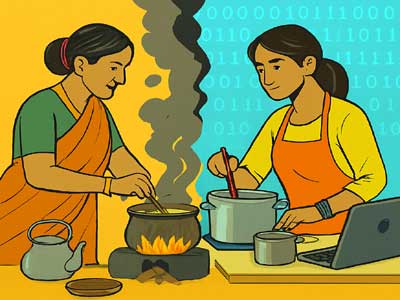Now and then, you’ll meet some nostalgic elder who won’t stop praising the smoky rotis cooked on a clay stove or the lentils that simmered for hours on a coal fire! Only those who’ve actually lit a chulha or stoked an angeethi know the struggle our women endured for centuries. Truly, the kitchen revolution began the day gas cylinders entered our homes.
There was a time when the kitchen in every Indian home was nothing short of a temple, and the cook, whether it was the mother, grandmother, or aunt, was no less than a goddess! She would rise before dawn, light the chulha with wood or cow dung cakes, eyes stinging with smoke but heart full of devotion. The gods on the wall got their daily offering first, and then the rest of us. Meals were simple, dal-roti or a potato curry, with pickle on the side, just to keep a little ‘spice’ in life.
Rewinding to those times, homemaker Padmini Iyer recalls, “Back then, the kitchen was a battlefield, spices fought wars, onions brought tears, and smoke ruined everyone’s makeup. But over time, our kitchens evolved, from smoke to smart, from wood to ‘Alexa, preheat the oven!’ The only difference is that earlier we spent time lighting the fire, and now we spend it searching for recipes on YouTube.”
In ancient times, cooking meant lighting a fire in the jungle, roasting whatever you could find, and eating by the grace of God. No recipes, no timers, if it didn’t burn, it was food. Then came the desi chulha, a miracle of clay that burned wood, coal, or cow dung. Yes, the very one you’re imagining. Lighting it was pure penance; you blew so much air you nearly turned into a furnace yourself. But the taste! Every smoky bite was worth forgiving the struggle.
And the angeethi? That magical winter box, warming your feet and cooking your soup at the same time. Chef Sahi says, “The Mughals brought a new fragrance to our kitchens, the tandoor. Fire blazing in an earthen pit, naan stuck to its walls, and kebabs sizzling on skewers, it wasn’t just food, it was poetry.” Royal kitchens became grand banquets; the common man’s kitchen became a diary of smoke. The cooks were blackened head to toe, the true ‘Black Beauties’ of the time!
Then came the British, and with them, the kerosene stove, the first ‘smelly’ symbol of modernity. No more hunting for firewood, but a new fear: when will the stove explode? Venkatesh Subramanian reminisces, “Every morning was an adventure. ‘Has the flame caught yet?’ followed by ‘Is the tea ready?’ Tea united India, and the smell of petrol woke everyone up.”
After Independence came the electric heater, glowing red coils that looked like aliens had landed. Sometimes it cooked vegetables, sometimes it burned sarees. Still, people loved it; after all, it didn’t smoke!
The true revolution arrived with LPG cylinders! Just twist a knob, and behold, fire! No wood, no smoke, no dung cakes. Only one fear, gas leaks. Retired teacher Meera Gupta recalls, “The delivery guy always came just when your favourite TV serial started. But the kitchen became clean, the lungs healthier, and the cooking faster. Though time-wise, nothing changed, we no longer light wood, but we spend half the day finding recipes.”
After 2000, the kitchen got a makeover. Gas pipelines, chimneys, and modular designs, the kitchen became a style statement. Clean air, glossy walls, and global cuisine. Induction cooktops, microwaves, and ovens, all touch-operated. Food gets hot in two minutes, or burns in two seconds, depending on your luck!
Young homemaker Uma says, “Today, the kitchen isn’t a kitchen, it’s a content studio. People take three photos before cooking and then wonder, ‘Should I cook it or post it?’ Meals are no longer fixed; we eat whenever we feel like. Dad’s on keto, mom’s vegan, kids eat fusion, everyone’s plate is different, but time’s the same. Someone’s making pav bhaji tacos, someone’s heating biryani in a mug.”
Grandma’s kitchen included one stove, one pan, and ten hungry mouths. The rule was simple: Eat what’s cooked. While the Granddaughter’s kitchen includes an oven, a mixer, an air fryer, and Alexa, who plays music and sets the timer too. Grandma laughs, “Child, I used to feed ten people on one stove. You spend three hours making avocado toast for two and call it exhausting!”
Today, our kitchens are hi-tech. The smoke is gone, but the confusion remains. We don’t need firewood anymore, but Wi-Fi. No allergies now, only algorithms.
And, the biggest question still echoes through every Indian home, “What’s for dinner?”










Related Items
Indusfood 2025: A global showcase of Indian Food Economy
Indian Thali in global spotlight for sustainability
Delicious sandwiches for all the seasons...